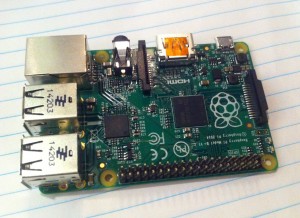The control system is responsible for processing and directing the signals of the our system. We have a variety of user inputs, which are sent to the system via buttons. The inputs are then go to an information display, which show whether the system is in automatic or manual mode. If it’s in manual mode, then the user can choose to move the knee or ankle and then whether to do flexion or extension. Additionally, in manual mode, the user controls how much flexion or extension occurs.
We chose the Raspberry Pi B+ to use as our control system. The RPI is a single-board computer; one of the reasons we chose it was because about half of our team members had some experience with the RPI. (The other reasons are listed in our design document.) Additionally, because of its popularity, we thought it would be useful to learn how to use it.

A photo of one of our Raspberry Pi B+ units.
As of 11/07/14, we’ve gotten the following done:
- A general outline of which GPIO pins will used and connected to what components.
- Programmed basic servo movements.
- Programmed Charlieplexing and button inputs.
As of 12/02/14, we need to get the following done for our end-of-semester demo to Dr. Peixoto:
- Program code for knee motor controller, ankle servo.
- Program code for info display (the LCD screen).
- Program interaction between the user control (button) and the motors.
